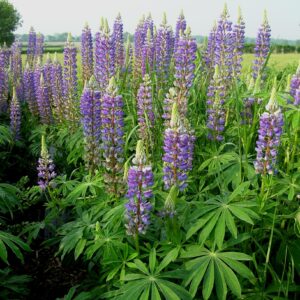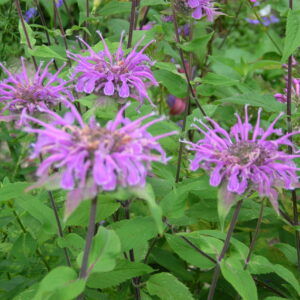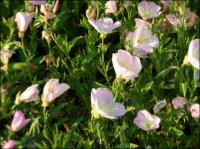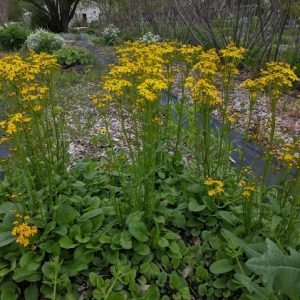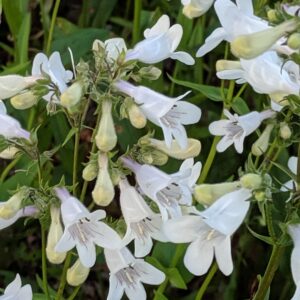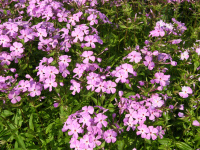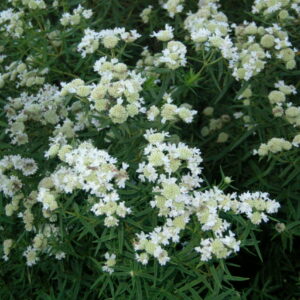Prairie Plants
Showing 57–64 of 81 results
-
Lupinus perennis Sun-dial lupin, Old maid’s bonnet, wild pea Z. 4-9
Many flowered blue, pea flowered raceme May-June
Many flowered blue, pea flowered raceme May-June
Size: 1-2' x 12"
Care: full sun in well drained soil. A legume, so it enriches the soil by adding nitrogen.
Native: Maine to FL, Ontario to MN to Louisiana, Wisconsin native.
Wildlife Value: Attracts both hummingbirds and butterflies. The only food for larvae of endangered species, Karner Blue butterfly.Lupinus is Latin from Lupus meaning “wolf.” Likely sent from its native Virginia to England by Tradescant the Younger in 1637. Certainly collected by Frenchman Michaux, who scoured eastern North American over 11 years in late 1700’s. Grown by Jefferson. Grown at America’s 1st botanic garden, Elgin Botanic Garden 1811.The Cherokee used this to stop bleeding. The Menominee fattened their horses with this Lupin and made them spirited. They rubbed the plant on themselves to give power to control the horses.
-
Monarda fistulosa Wild bergamont Z 3-9
Whorls of hooded lavender tubes in July - August
Whorls of hooded lavender tubes in July – August
Size: 3-4' x 2' spreading
Care: Sun to part shade any soil.
Native: central U.S., Wisconsin native
Wildlife Value: Checkered white, Tiger swallowtail, Giant swallowtail and Melissa blue butterflies relish Wild bergamot’s nectar. Supports over 70 bee species including Rusty patched Bumble Bee.Used medicinally by many Native tribes- Blackfoot, Cherokee, Chippewa, Choctaw, Crow, Dakota and Flathead. Cherokee: to cure colic, flatulence, nosebleed, measles, flu, hysteria and to induce restful sleep Blackfoot called it “Single-young-Man.” Teton Dakotas boiled the leaves and flowers for medicine to cure abdominal pain. Ho-Chunk boiled the leaves to make a medicine for pimples. Choctaws cured chest pain in children. The Flathead cured colds and sore teeth with Wild Bergamot. HoChunk inhaled fumes in a sweat bath to cure colds. Oneidas made a tea. For the Sioux it was nourishment and a panacea: tea, stomachache, fever, indigestion, sore throats, fainting, whooping cough, wounds, sore eyes, ulcers, and snakebites. First documented by French explorers before 1635. Plant exported to Europe by Tradescant the Younger in 1637. Grown by Washington at Mount Vernon. Today it is a flavor in Earl Grey tea.
-
Oenothera speciosa Evening primrose Z 5-8
June to August pale pink saucer-like blossoms
ARCHIVED
Note: This is a plant not currently for sale. This is an archive page preserved for informational use.
June to August ballerina pink saucer-like blossoms, excellent groundcover.
Size: 12" x 12" spreader
Care: Full sun moist well-drained to well-drained soil
Native: Southwest U.S. to MexicoAnother Thomas Nuttall discovery – 1819.
-
Packera obovata syn. Senecio obovata Round-leaved ragwort, Golden groundsel Z. 3-8
Clusters of perky yellow daisies with sunny centers atop nearly leafless, erect stems, blooming late spring to early summer. Missouri Botanic Garden: “Vigorous spring wildflower for sunny or shady areas of the landscape. Large, naturalized plantings in woodland gardens can be spectacular in bloom. Cut off flowering stems after bloom and enjoy the semi-evergreen basal foliage which forms an attractive ground cover.”
Clusters of perky yellow daisies with sunny centers atop nearly leafless, erect stems, blooming late spring to early summer. Missouri Botanic Garden: “Vigorous spring wildflower for sunny or shady areas of the landscape. Large, naturalized plantings in woodland gardens can be spectacular in bloom. Cut off flowering stems after bloom and enjoy the semi-evergreen basal foliage which forms an attractive ground cover.”
Size: 1-2’ x 6-12” spreading
Care: sun to part shade in moist to moist well-drained soil
Native: curved swath from eastern Canada to FL west to IL and NM
Wildlife Value: attracts bees. Deer resistantObovata means egg-shaped describing the shape of its basal leaves. First named in 1803 from a plant of Rev. Henry Muhlenberg (1783-1815) (https://en.wikipedia.org/wiki/Gotthilf_Heinrich_Ernst_Muhlenberg,) Pennsylvania plantsman, sent to German botanist Carl Ludwig Willdenow (1765 – 1812). Packera named for a Canadian botanist, John G. Packer.
-
Parthenium integrifolium Wild Quinine Z 3-8
Work-horse white cymes July through October
Work-horse white cymes July through October
Size: 2-3’ x 12”
Care: sun in moist well-drained soil
Native: Mass. To Georgia & Minn. To Arkansas, incl. WI
Wildlife Value: provides nectar and pollen to native bees.Seeds are fragrant when crushed. Named “quinine” because it was used to treat fevers similar to malaria. Catawabe Indians used the leaves to treat burns and the flowers to treat fever. 1st described in literature in 1732.
-
Penstemon tubaeflorus Great Plains Beardtongue 4-8
Spikes of swan white trumpets with flared ends blooms in early summer. One of most reliable, long lived penstemons.
Spikes of swan white trumpets with flared ends blooms in early summer. One of most reliable, long lived penstemons.
Size: 2-3’x 15”
Care: Sun in well-drained to moist well-drained soil
Native: Central Plains N., S. to TX & NE to Maine, Wisconsin native
Wildlife Value: feeds Baltimore butterfly, other butterflies, bees and hummingbirdsPenstemon is named for its five stamens, penta meaning five and stemon meaning stamen in Greek. Collected by English botanist Thomas Nuttall (1786-1859) who searched entire No. American continent – parts of Canada, from New England west to Oregon, parts of the South, Midwest, the Plains, the S.E., California & Hawaii, finding hundreds of new plants.
-
Phlox buckleyi Sword leaf Phlox Z 4-8
Sprays of mauve, pink or purple in May-June
OUT OF STOCK
Sprays of mauve, pink or purple in May-June
Size: 8- 18” x 12”
Care: sun to part shade in any soil
Native: Virginia & West VirginiaBob from Texas reports “they are absolutely the most fragrant flowers we have ever experienced. We only pick a few each spring and put them in a vase in the house with sugar sweetened water. They produce that amazing fragrance in the house for virtually two full weeks in that vase while the rest put that aroma across the back yard. Sword Leaf Phlox is simply an amazingly beautiful plant.”
Described and named by Edgar Theodore Wherry (1885-1982), unflagging naturalist in the finest tradition of wide interests in the natural world. After getting his Ph.D. in 1909 in geology-mineralogy he became Asst. Curator of Minerals for the Smithsonian. In 8 years he transferred to the USDA Bureau of Chemistry, becoming its principal chemist. In 1930 he was appointed botany professor at U. Penn., where he taught botany and ecology for 25 years.**LISTED AS OUT OF STOCK BECAUSE WE DO NOT SHIP THIS ITEM. IT IS AVAILABLE FOR PURCHASE AT OUR RETAIL LOCATION.
-
Pycanthemum virginianum Mountain mint Z 4-8
Corymbs of numerous pinkish-white blossoms, leaves fragrant.
Corymbs of numerous pinkish-white blossoms in August, leaves fragrant.
Size: 3' x 18"
Care: full sun to part shade in moist well-drained to well-drained soil
Native: Wisconsin native, Eastern U.S.
Wildlife Value: attracts butterflies, supports over 50 bee species.Named by Linnaeus in 1753. Pycanthemum is Greek meaning “dense blossom.” Chippewa used it to stop menstrual flow, cure chills and fever and to season meat. The plant gave the Meskwaki energy and lured minks into their traps. Lakota Sioux: “The leaves make a very pleasant tea. An infusion of the plant is taken for coughs.” Grown at America’s 1st botanic garden, Elgin Botanic Garden 1811

